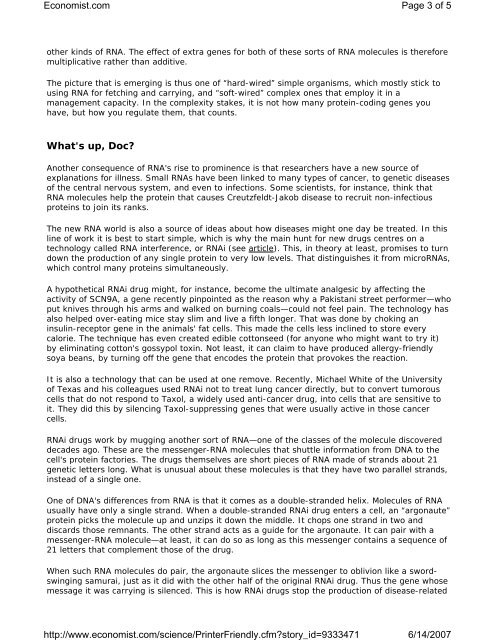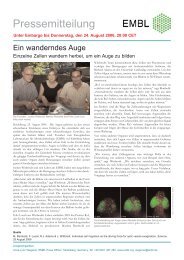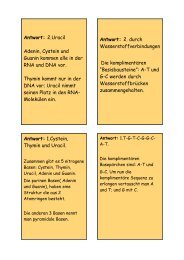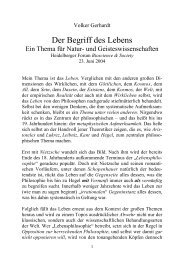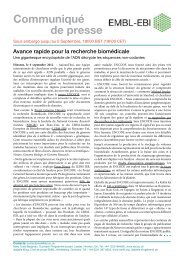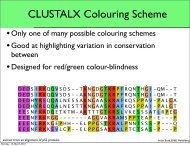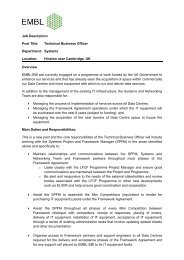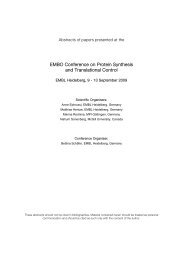Media Clips - EMBL
Media Clips - EMBL
Media Clips - EMBL
Create successful ePaper yourself
Turn your PDF publications into a flip-book with our unique Google optimized e-Paper software.
Economist.com<br />
other kinds of RNA. The effect of extra genes for both of these sorts of RNA molecules is therefore<br />
multiplicative rather than additive.<br />
The picture that is emerging is thus one of “hard-wired” simple organisms, which mostly stick to<br />
using RNA for fetching and carrying, and “soft-wired” complex ones that employ it in a<br />
management capacity. In the complexity stakes, it is not how many protein-coding genes you<br />
have, but how you regulate them, that counts.<br />
What's up, Doc?<br />
Page 3 of 5<br />
Another consequence of RNA's rise to prominence is that researchers have a new source of<br />
explanations for illness. Small RNAs have been linked to many types of cancer, to genetic diseases<br />
of the central nervous system, and even to infections. Some scientists, for instance, think that<br />
RNA molecules help the protein that causes Creutzfeldt-Jakob disease to recruit non-infectious<br />
proteins to join its ranks.<br />
The new RNA world is also a source of ideas about how diseases might one day be treated. In this<br />
line of work it is best to start simple, which is why the main hunt for new drugs centres on a<br />
technology called RNA interference, or RNAi (see article). This, in theory at least, promises to turn<br />
down the production of any single protein to very low levels. That distinguishes it from microRNAs,<br />
which control many proteins simultaneously.<br />
A hypothetical RNAi drug might, for instance, become the ultimate analgesic by affecting the<br />
activity of SCN9A, a gene recently pinpointed as the reason why a Pakistani street performer—who<br />
put knives through his arms and walked on burning coals—could not feel pain. The technology has<br />
also helped over-eating mice stay slim and live a fifth longer. That was done by choking an<br />
insulin-receptor gene in the animals' fat cells. This made the cells less inclined to store every<br />
calorie. The technique has even created edible cottonseed (for anyone who might want to try it)<br />
by eliminating cotton's gossypol toxin. Not least, it can claim to have produced allergy-friendly<br />
soya beans, by turning off the gene that encodes the protein that provokes the reaction.<br />
It is also a technology that can be used at one remove. Recently, Michael White of the University<br />
of Texas and his colleagues used RNAi not to treat lung cancer directly, but to convert tumorous<br />
cells that do not respond to Taxol, a widely used anti-cancer drug, into cells that are sensitive to<br />
it. They did this by silencing Taxol-suppressing genes that were usually active in those cancer<br />
cells.<br />
RNAi drugs work by mugging another sort of RNA—one of the classes of the molecule discovered<br />
decades ago. These are the messenger-RNA molecules that shuttle information from DNA to the<br />
cell's protein factories. The drugs themselves are short pieces of RNA made of strands about 21<br />
genetic letters long. What is unusual about these molecules is that they have two parallel strands,<br />
instead of a single one.<br />
One of DNA's differences from RNA is that it comes as a double-stranded helix. Molecules of RNA<br />
usually have only a single strand. When a double-stranded RNAi drug enters a cell, an “argonaute”<br />
protein picks the molecule up and unzips it down the middle. It chops one strand in two and<br />
discards those remnants. The other strand acts as a guide for the argonaute. It can pair with a<br />
messenger-RNA molecule—at least, it can do so as long as this messenger contains a sequence of<br />
21 letters that complement those of the drug.<br />
When such RNA molecules do pair, the argonaute slices the messenger to oblivion like a swordswinging<br />
samurai, just as it did with the other half of the original RNAi drug. Thus the gene whose<br />
message it was carrying is silenced. This is how RNAi drugs stop the production of disease-related<br />
http://www.economist.com/science/PrinterFriendly.cfm?story_id=9333471<br />
6/14/2007


